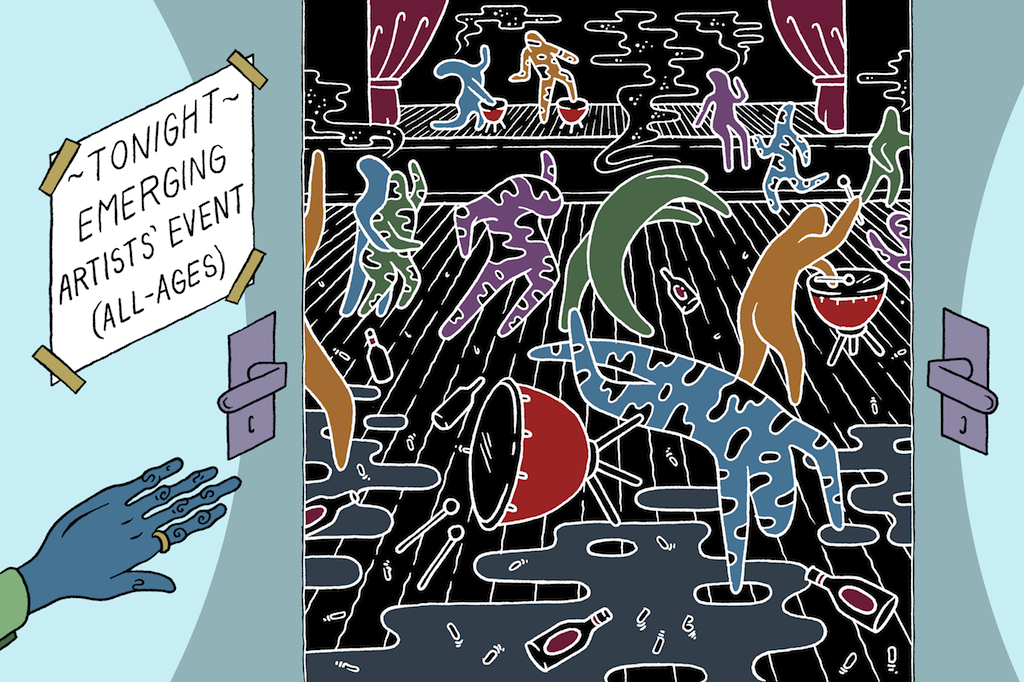Keeping a Roof Over Our Heads
It’s 6:58 a.m. I wrench myself away from sleep to answer my phone.
“I need you here,” says Vikki, my best friend and business partner. “I can’t handle it alone.”
I speed to our newest arts space and am greeted by a piercing fire alarm. Water is dripping from the ceiling into the board that controls the alarm, and it won’t shut off. The system is fried. In this moment, I learn that the word horror can be defined as learning that all three toilets in the bathroom above are clogged and overflowing.
Abandoning the alarm, I make my way to the stairs, and an unexpected smell hits me. Something more than just dirty bathrooms must lie ahead. Pot? Yep, that’s pot. Despite my growing trepidation, I realize the pounding sensation in my chest isn’t just coming from my racing heart. Drums are also thundering around me.
Wait…. why are there drums?
I reach the top of the stairs and in one sweep take in the full crisis. A commercial production company has rented our theatre today to film a project involving a fifteen-piece kettledrum band, and they arrived at 7:00 a.m. Surrounding the drummers are empty mickeys of vodka, rum, and gin, left behind from last night’s event. I have never seen bottles that big. The floor is covered in cigarette butts and loose tobacco that the production team has hastily swept to the edges of the room in their best effort to make the space usable for their shoot. Everything is sticky. Scattered drug baggies embellish the disarray. We worked hard to book this production company, and now we’re going to have to refund them a large rental fee.
In a fog, I make my way to the office where Vikki is holding our hostage: the young man who rented the theatre last night to host an “emerging artist showcase” event. A showcase for teen and preteen musicians, with no alcohol allowed, the contract had specified. In a final act of poor judgement, he had returned this morning to retrieve a sweater he’d left behind. Vikki dials the number for his parents as I hold up the condom I peeled off the bottom of my shoe.
I look him in the eyes.
“I’m just… disappointed,” I say.
I am a theatre artist. I started out trying to “make it” as an actor in the traditional sense. I would go to auditions, book commercials I was embarrassed to be seen in (a vegetarian selling KFC? come on…), and face the normal rejection over and over. Sick of constantly feeling unfulfilled, I decided to try to “make it” in a literal sense. As in, make my own art.
The first time I decided to self-produce, in all my naive glory, I called up Factory Theatre. “Hi, I’m a recent theatre school grad putting up a show. Do you offer discounts for young and emerging theatre companies?” The answer was no. I was outraged. Did they not know that I was an artist and I didn’t have money and my story was important?
After a hunt on SpaceFinder, I found a small indie theatre space called the Grocery, and I opened my production there. For the first time since graduating from theatre school, I felt really happy. I was creating something that I believed in, that I was proud of. Best of all, I had made it. Only a year after opening, however, the Grocery was forced to close, and I was faced with a stark reality: there was no where else for me to go. But I also saw this as an opportunity. If I was struggling to find space, there had to be other artists in the same situation. Instead of going back to auditioning, or searching for other theatres to rent, I began hunting for a commercial unit of my own that would allow me to continue making work while providing space for others. I found a beautiful little spot, just a block from the Grocery, and opened the Attic in October 2015.
Little did I know, Vikki had gone through an almost identical journey of her own and was already running a studio and theatre space: the Box.
Our meeting was serendipitous. Vikki rented the Attic from me to rehearse one of her productions because the Box was fully booked. She called me during her rehearsal, in the dead of winter, because the furnace had suddenly stopped working. I sprang into action, rushing over to play HVAC technician and customer service rep, apologizing profusely while replacing the parts I had Googled. She didn’t yell at me for ruining her rehearsal, and I didn’t leave her stranded in the cold, so it was basically love at first sight. We knew that as a pair we would be stronger, so we married our spaces to build Brick and Mortar, and opened a third space together.

Vikki, left, and Kasey, right
You’ll be surprised to know that as little girls, we didn’t dream of growing up to be furnace fixers, toilet uncloggers, locksmiths, and general contractors. Running an arts space is not glamorous. Some days, it feels like all we do is mop floors. What we love to do is tell stories, to be involved in bringing people together. Our spaces provide a place for people to deliberately exist in a moment that will never happen again. The Attic offered a way for me to produce my own work, but it quickly grew into something bigger: a vehicle to help artists share their stories with the world. When we achieve that, it makes it all worthwhile.
Toronto has watched many small spaces close over the past year. We said goodbye to the Grocery, Unit 102, the Fort, Videofag, Storefront Theatre, Fraser Studios, and the Fringe Studios, and we are now losing Storefront Studios.
One of our own spaces was forced to close last year, too. We had finally reached a point where we could hire some help for cleaning and maintenance, so were conducting interviews. The first candidate beat us to the theatre and was waiting in the lobby with the envelope they had found taped to the front door. I made small talk as I led them inside and opened the letter.
Evicted.
My heart hit my intestines and my face burned. Evicted. I tried to mask my inner panic.
Vikki arrived and called for help from the front door. I excused myself and peered out the window to my lovely partner who was single-handedly hauling up the couch she had found for free on the side of the street. “You may want to leave it outside,” I called down. She saw my face and just knew.
They evicted us to renovate. We were invited to return after the work was complete at triple the cost. Knowing we couldn’t ask our artists to absorb such an increase, we began hunting for a new space. Navigating commercial tenancy in this city is a story all to its own—rent is exorbitant, and it seems there is no shortage of creepy real estate agents who joke about slipping us roofies or ask to film us doing renovations in bikinis. Don’t get me started on the landlords.
After our eviction, we felt like we had failed. Failed our business, failed the community, failed each other. Through that failure, however, we learned how to write better contracts and how to protect ourselves, and we gained clearer insight into what artists really need. This knowledge fuelled our search for the perfect new location. We were incredibly fortunate to find an established arts space that was closing its doors: Opia Studios. We took over the location and reopened as the Commons Space in January 2017. It was bittersweet to add a space while losing another.
Our main competition is backyards, living rooms, parks, and condo lobbies. If artists are going to spend their money on an arts space, then it had better meet their every need. The list of expectations is great: a clean, private, beautiful space stocked with furniture and tech equipment, managed from a distance with respect for their artistic process. And we have to consider the demands of neighbours and landlords, along with managing the bills. The expectations are great, even though the budgets never are.
Our greatest strength? The artists. There is no shortage of creators who want to create. Every year, more and more artists take up the torch and start searching for a space where they too can “make it.”
I often think back to the time I tried to rent Factory Theatre. They did know I was an artist, and that I didn’t have any money, and that my story was important to me. Yes, they knew. But they also knew that their work is too important to put themselves at risk of closure. It wasn’t until I began running Brick and Mortar that I could see the bigger picture: artists need affordable arts spaces, but in order for those spaces to stay open and flourish, they have to earn enough to be sustainable.
The people who run arts spaces are fighting for you. We are you. So be kind. Be patient. Do not ask for free space. If you have no budget, offer something else: your time, your work, profit shares. Please be understanding when discounts aren’t possible. If you arrive to find the garbage overflowing, forgive whatever slob left it that way. If you want to go the extra mile you can even take it out! We apologize for the hot dog that someone left between the couch cushions, and for the bagel that was dropped in the greenroom. Know that we are on your side and we are just as disappointed as you are.
We are in this together.
And, please, don’t host secret illegal raves and call them all-ages emerging artists’ events.
We really don’t like that.
Kasey and Vikki have a show on now at the Toronto Fringe! For more info about Real Actors. Not People., click here










Comments